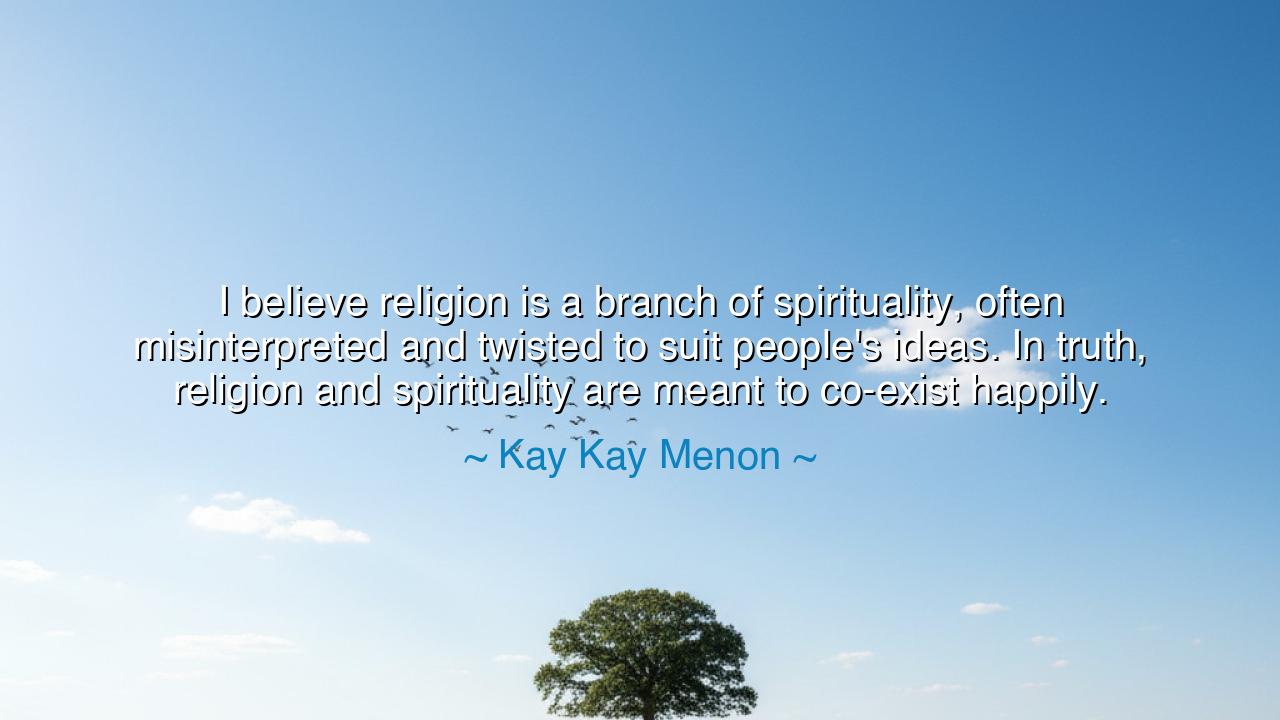
I believe religion is a branch of spirituality, often
I believe religion is a branch of spirituality, often misinterpreted and twisted to suit people's ideas. In truth, religion and spirituality are meant to co-exist happily.






"I believe religion is a branch of spirituality, often misinterpreted and twisted to suit people's ideas. In truth, religion and spirituality are meant to co-exist happily." These words by Kay Kay Menon speak to a deep and essential truth about the relationship between religion and spirituality—two forces often seen as one, yet fundamentally different in their nature and application. Religion—with its structured practices, rituals, and doctrines—can sometimes be misinterpreted, used as a tool to control or manipulate, rather than a means to connect with the divine or the sacred. Spirituality, on the other hand, is the more personal, intuitive, and experiential connection with the divine, often transcending institutional boundaries. Menon’s insight suggests that true religion and spirituality should not be at odds, but rather should co-exist in a harmonious relationship, where faith and personal connection to the divine complement each other.
In the ancient world, the relationship between religion and spirituality was not always so divided. Greek philosophy, for instance, often explored the divine in ways that bridged both religion and spirituality. Plato, in his works, spoke of a higher truth and reality, one that could be approached through both reason and spiritual experience. For Plato, religion—the belief in the gods—was intertwined with the philosophical search for truth, for the gods were seen as embodiments of moral and natural laws that governed the universe. Plato and his followers did not see religion as mere ritualistic practice, but as a way to connect with the cosmic and spiritual forces that structured the world. This ancient understanding resonates with Menon’s view: that religion and spirituality should not be separated, but rather should work together to elevate human understanding of the divine.
Similarly, the teachings of Buddhism offer a profound example of how religion and spirituality can exist in harmony. Buddha taught that the path to enlightenment is not bound by dogmatic rituals, but rather by personal experience and practice—the cultivation of mindfulness, compassion, and wisdom. While the religious aspects of Buddhism provide a framework for practice—through meditation, ethical conduct, and study—the true essence of the path lies in personal spiritual experience. This reflects Menon’s point that religion can provide the structure, but spirituality is the means by which one experiences the divine truth and connection. The religion of Buddhism provides guidance, but it is the spiritual practice that leads to inner transformation.
In more modern times, we can look to Mahatma Gandhi as an example of someone who navigated the interplay between religion and spirituality. Gandhi, deeply rooted in his Hindu faith, saw religion not as a dogmatic structure, but as a pathway to spiritual growth. He practiced ahimsa (nonviolence) and satya (truth) as the core of his spiritual beliefs, yet these principles were deeply embedded in his understanding of religion. For Gandhi, the practice of spirituality—in the form of love, truth, and nonviolence—was the essence of his religion, and his actions were shaped by this understanding. His life demonstrates that religion can provide the moral and ethical framework for spiritual living, while spirituality brings it to life in action and personal experience.
The words of Kay Kay Menon reflect the importance of balance between religion and spirituality in our lives. When religion is rigidly enforced, disconnected from the individual’s personal connection to the divine, it can become a force for division, guilt, and control. But when religion is approached with an open heart and a genuine desire to experience the divine, it can guide one to spiritual freedom and inner peace. Spirituality, when practiced without the bounds of rigid dogma, invites the soul to engage in a direct, personal relationship with the divine, fostering a deeper understanding of life’s mysteries. Menon’s insight encourages us to not reject either religion or spirituality, but to find a way for them to co-exist and support each other, bringing us closer to the divine.
The lesson here is one of integration and awareness. We must learn to appreciate the role of religion in providing structure, community, and a moral framework, while also embracing spirituality as a means of personal connection and growth. Just as Plato and Buddha found ways to merge these two forces, we too must seek to integrate religion and spirituality in a way that honors the inner truth of the individual while remaining open to the wisdom of the collective teachings of our faith. Faith is not a one-size-fits-all construct; it is a journey that blends the external structures of religion with the internal experiences of spirituality.
In practical terms, we can apply this understanding by being open to both religious practices and spiritual exploration. Prayer, meditation, rituals, and community worship can be part of our spiritual practice, but they should not be seen as ends in themselves. They are simply tools to help us connect to the divine within and around us. We must also take time for personal reflection, self-awareness, and compassion, allowing spirituality to flow freely and guide us in our actions, decisions, and relationships. Just as Gandhi practiced the principles of ahimsa and satya, we too can live our spirituality in everyday actions, using our religious practices as a foundation for spiritual growth.
By seeking harmony between religion and spirituality, we create a life that is not only grounded in tradition and community but also deeply connected to the inner divine. This balance enables us to walk a path of integrity, compassion, and truth, leading to both personal fulfillment and peace with the world around us. Let us, therefore, embrace both the structure of religion and the freedom of spirituality, and allow them to guide us on our journey toward inner peace and divine connection.






AAdministratorAdministrator
Welcome, honored guests. Please leave a comment, we will respond soon